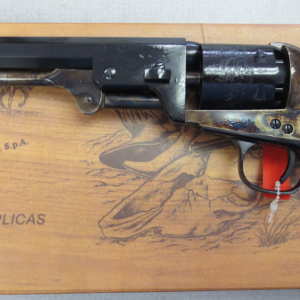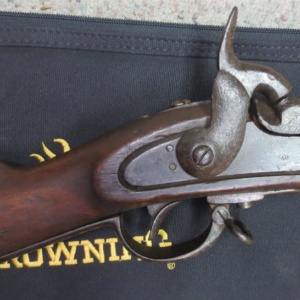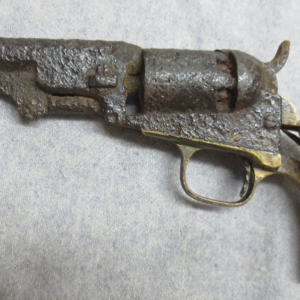Description
This is an absolutely stunning example of this scarce weapon which was produced from 1857 until 1860 by both the Springfield and Harpers Ferry armories. With a total production by Springfield of 47,115 this is one of the last ones produced prior to the Civil War and it is a beauty! An extra bonus is the original leather infantry sling as well as the weapon having issue rack numbers stamped on several metal parts.
All metal overall is fine and all markings are crisp and vivid. The bore is excellent and the weapon honestly shows very little use. The barrel tang is also dated 1860 and all parts are original as issued.
The M1855 rifle-musket was the first U.S. regulation arm to use the .58-cal. hollow-base Minié type bullet. Then-Secretary of War Jefferson Davis authorized the adoption of the M1855 as the U.S. Army’s standard arm on July 5, 1855, replacing the .69-cal. M1842 percussion smoothbore musket.
One of the rifle-musket’s new features was the Maynard tape primer system which was patented on Sept. 22, 1845 by Baltimore dentist Dr. Edward Maynard. Its purpose was to eliminate the need to manually place a percussion cap on the nipple each time the gun was fired. A paper roll carrying the priming compound was advanced over the nipple each time the hammer was cocked. When the trigger was pulled, the hammer struck the primer, which was an explosive fulminate section incorporated into a strip of paper. The fulminate would detonate, driving a jet of flame through the nipple to ignite the main powder charge and thus firing the rifle-musket. The system was similar to that of a toy cap gun. The rifle-musket could still be fired with the conventional percussion cap.
The 9-pound, 3-ounce U.S. M1855 rifle-musket had an overall length of 56 inches. The 40-inch-long barrel, finished in the bright, was equipped to accept a socket bayonet. The upper left barrel flat was stamped with the proofmarks “V/P” and an eagle head and the production date was marked on the top barrel flat near the breech. The nipple bolster was equipped with a clean-out screw and the three flat barrel bands were retained by conventional band springs. The sling swivels were on the middle barrel band and trigger guard. All the furniture on this model was made of steel in the bright, including the buttplate, which was stamped with a “US.” The M1855s used a swelled-shaft, tulip-head steel ramrod.
The Maynard tape primer door was fitted to the lockplate forward of the C-shaped hammer. Within the compartment, a roll of 50 Maynard tape primers was held. The lockplate was stamped either “U.S./SPRINGFIELD” or “U.S./HARPERS FERRY” forward of the primer door in two lines, depending on which of the government facilities manufactured the rifle-musket. The date was stamped to the rear of the hammer on the lockplate’s rear. The Maynard tape primer door was stamped with a large spread eagle.
It is of interest to note that this fine weapon surfaced in California. Prior to the war, many M1855s were sent to California for issue to the regulars and the state militia units. The 350 rifle-muskets delivered to the state in 1860-1861 were issued to the state militia. In early 1860, Benicia Arsenal reported 7,252 M1855s on hand and the arsenal supplied the state volunteer infantry regiments formed during the war with M1855s. As late as 1865, the Department of the Pacific listed M1855 rifle-muskets with the 2nd, 4th, 6th, 7th and 8th California Infantries, plus the 1st Nevada Infantry. This may well be one of the examples that found its way westward which has now come back to the east!
Southern states obtained a quantity of M1855 rifle-muskets on their state militia allotments before the war. Florida drew 100 on its 1860 allotment and a Georgia adjutant general report dated Feb. 26, 1861 indicated the state had received 1,225 M1855s. Tennessee’s 1860 allotment called for 701 M1855 rifle-muskets and 381 M1855 cadet rifle-muskets. Alabama also received 150 of the shorter M1855 cadet rifle-muskets. The major difference between the two rifle-muskets was the length of the barrel. The cadet barrel was 38-inches long, giving it a slightly shorter overall length than the standard rifle-musket.
When Louisiana state troops seized the Baton Rouge Arsenal on Jan. 10, 1861, the state obtained an additional 1,099 M1855 rifle-muskets. Two of the state’s infantry units partially armed with the M1855 rifle-muskets were the 13th Louisiana Infantry Battalion (Orleans Guards), which fought at Shiloh, and the 1st Regular Louisiana Infantry.
Northern states also received M1855 rifle-muskets on their yearly militia allotments in the late 1850s. Connecticut received 1,020 M1855s by January 1861, Kansas 600, Maine 580, Maryland 400, Wisconsin 302 and Iowa 100. Vermont received 300 after the start of the war in 1861.
The states of Michigan, Delaware, Massachusetts and Pennsylvania also received M1855 rifle-muskets as part of their allotments. In 1858, New York sent a politically connected delegation to Washington to obtain 1,000 of the new M1855 Springfield rifle-muskets for issue to the 7th New York State Militia and they were issued to the state in November. In 1861, New York received an additional 2,951 M1855s to help arm the state’s volunteer infantry regiments being mustered into federal service.









